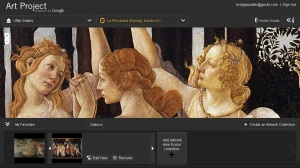Gone are the days where cell phones are strictly forbidden at museums. At least at the Cleveland Museum of Art , one of the world’s most distinguished art institutions. I visited the Cleveland Museum of Art a few weeks ago and was amazed by the hidden nuggets that cell phones are revealing. Where some museums have signs reminding you of the prohibition of cell phones, the CMA has signs encouraging you to use your smart phone. They’re just not using the smart phone in one particular way. They are using both QR codes for advertising and mobile phone tours.
QR is short for Quick Response, and the codes are two-dimensional black and white squares arranged in a specific matrix, much like that of a barcode. QR codes were originally used for vehicle manufacturing, but as you can tell these nifty little squares of technology are becoming quite popular outside the world of manufacturing. Artist Fabrice de Nola is working with QR codes within her oil paintings and QR Arts is turning practical and actual QR codes into designs for companies.
According to Museum Media the CMA is the first museum in Northeast Ohio to attempt to use QR codes. The Vancouver Opera and the Palm Beach Opera are also using QR codes in their advertisements. The codes were placed within advertisements in June 2010 for the reopening of the museum after its massive remodel and ongoing expansion. The codes directed people to the museums new website and allowed people to plan their trips to the free museum.
Tim Brokaw, managing partner of Brokaw Inc., the firm responsible for helping the CMA create the campaign said, “The art museum chose to experiment with QR codes for the first time to become more attractive to those people who often are early adopters of technology and are willing to try new things.”
QR codes are not the only new technology the Cleveland Museum of Art is using. They have started to use mobile phones for tours with the help of Earprint Productions. Founded by Jason Reinier, Earprint Productions, specializes in creating “exhibit design, mobile tours and apps, and scriptwriting for the museum community.”
Earprint Productions created an online and mobile tour called Art Conversations. Narrated by Dee Perry, “Art Conversations features voices of museum professionals, local artists, community members, and experts.” The audio is clear and allows the listening to hear these great insights without renting an antiquated listening device. We are now able to listen to mobile tours without wondering who used the device last. Unfortunately my phone did have some trouble receiving information, but other people within my group did not have the same problems. I blame my phone and not the technology.
Along with tapping into the smartphone niche the Cleveland Museum of Art has started their own blog. Within the blog contains posts about exhibits, artists and the construction project at the museum. I am glad that the Cleveland Museum of Art is advancing past what other museums are doing and into the world of technology.



